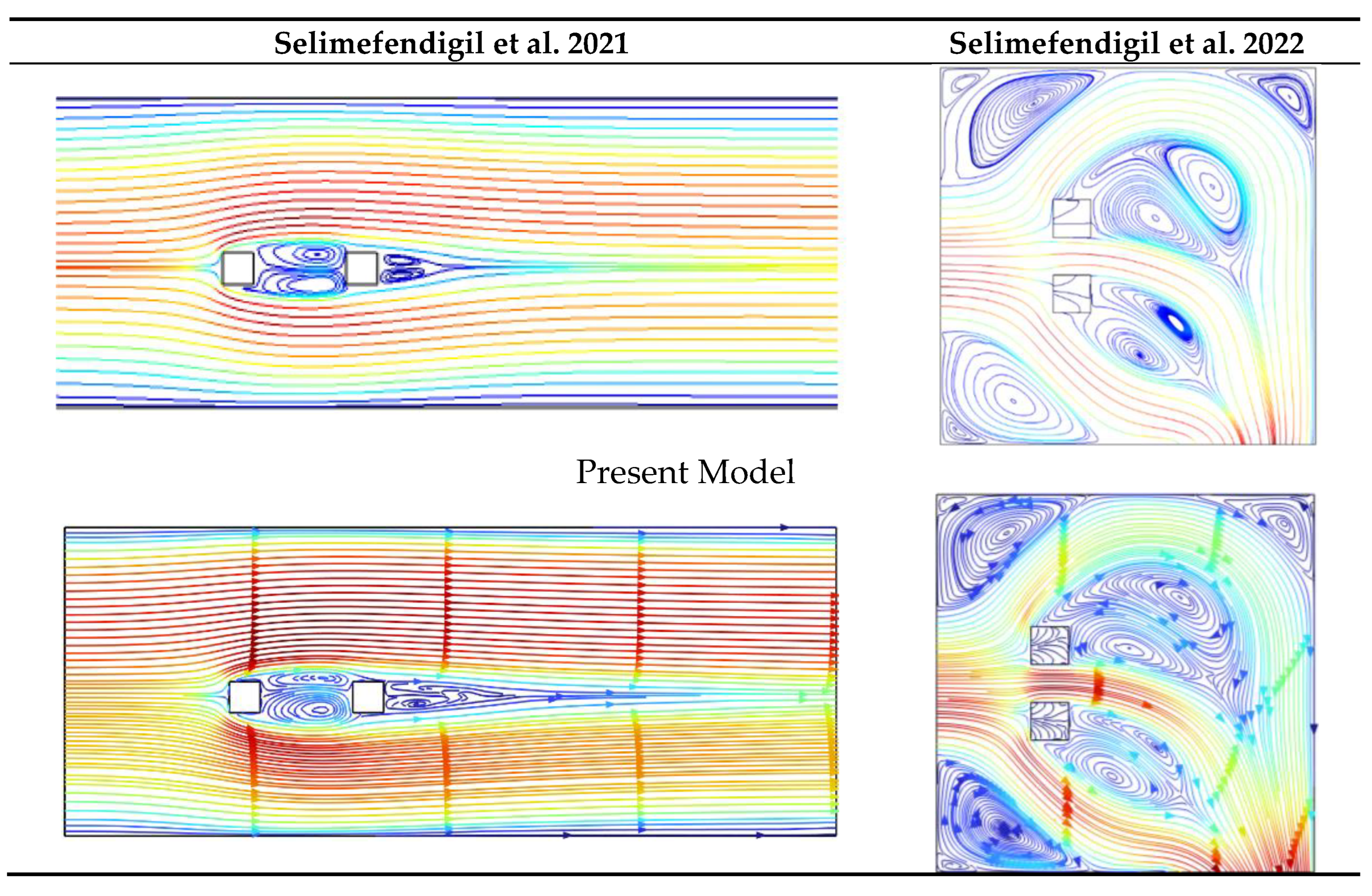Numerical Analysis of Building Cooling Using New Passive Downdraught Evaporative Tower Configuration in an Arid Climate
Abstract
1. Introduction
2. Governing Equations and Numerical Procedure
- At the inlet: Uy = –uin, T = Tin, , , , , and φ = 0.25.
- At the outlet: ; .
- At the walls: , where n is the normal vector.
3. Numerical Model Verification and Grid Independency TEST
4. Results and Discussion
4.1. Flow Structure
4.2. Temperature Distribution
4.3. Humidity Profiles
4.4. Occupation Area Study
5. Conclusions
- Regardless of the air extraction position, the flow topography is always similar. Indeed, the air movement in the chamber is always characterized by a single-cell flow turning in a counter-clockwise direction.
- The velocity and temperature at the chimney inlet play an important role in the air conditioning quality. In fact, a temperature reduction of about 7 degrees and a relative humidity increase of 9% can be achieved inside the room for low inlet velocities.
- The right-side roof air extraction with low capture velocity gives the best cooling efficiency.
- The best conditions for increasing the relative humidity were found for the lowest available wind speed and temperature (Tin =35 °C and uin = 0.5 m/s). Furthermore, it should be mentioned that the position of the air outlet has no significant impact on the humification of the occupied space.
Author Contributions
Funding
Conflicts of Interest
References
- Depren, S.K.; Kartal, M.T.; Çelikdemir, N.Ç.; Depren, Ö. Energy consumption and environmental degradation nexus: A systematic review and meta-analysis of fossil fuel and renewable energy consumption. Ecol. Inform. 2022, 70, 101747. [Google Scholar] [CrossRef]
- Mesloub, A.; Ghosh, A.; Albaqawy, G.A.; Noaime, E.; Alsolami, B.M. Energy and Daylighting Evaluation of Integrated Semitransparent Photovoltaic Windows with Internal Light Shelves in Open-Office Buildings. Adv. Civ. Eng. 2020, 2020, 8867558. [Google Scholar] [CrossRef]
- Mesloub, A.; Ghosh, A.; Touahmia, M.; Albaqawy, G.A.; Alsolami, B.M.; Ahriz, A. Assessment of the overall energy performance of an SPD smart window in a hot desert climate. Energy 2022, 252, 124073. [Google Scholar] [CrossRef]
- Salavatian, S. Innovative Renewable Energy. In The Importance of Greenery in Sustainable Buildings; Springer International Publishing: Berlin/Heidelberg, Germany, 2021; pp. 255–272. [Google Scholar]
- Michalak, P. Thermal—Airflow Coupling in Hourly Energy Simulation of a Building with Natural Stack Ventilation. Energies 2022, 15, 4175. [Google Scholar] [CrossRef]
- Kravchenko, I.; Kosonen, R.; Jokisalo, J.; Kilpeläinen, S. Performance of Modern Passive Stack Ventilation in a Retrofitted Nordic Apartment Building. Buildings 2022, 12, 96. [Google Scholar] [CrossRef]
- Mankani, K.; Nasarullah Chaudhry, H.; Kaiser Calautit, J. Optimization of An Air-cooled Heat Sink for Cooling of a Solar Photovoltaic Panel: A Computational Study. Energy Build. 2022, 270, 112274. [Google Scholar] [CrossRef]
- Francis, E. The Architecture and Engineering of Downdraught Cooling: A Design Source Book; PHDC Press: London, UK, 2010. [Google Scholar]
- Ford, B.; Schiano-Phan, R.; Vallejo, J.A. The Architecture of Natural Cooling, 2nd ed.; Routledge: London, UK, 2019. [Google Scholar]
- Bhamare, D.K.; Rathod, M.K.; Banerjee, J. Passive cooling techniques for building and their applicability in different climatic zones—The state of art. Energy Build. 2019, 198, 467–490. [Google Scholar] [CrossRef]
- Alshenaifi, M.; Sharples, S. Investigating the Impact of Architectural Form and Wind Direction on the Performance of a Passive Downdraught Evaporative Cooling Tower in Saudi Arabi. In Proceedings of the 34th International Conference on Passive and Low Energy Architecture, Hong Kong, China, 10–12 December 2018; pp. 294–299. [Google Scholar]
- Alshenaifi, M.; Sharples, S. Monitoring the performance of a passive downdraught evaporative cooling (PDEC) system—A case study of a library in Saudi Arabia. In Comfort at the Extremes 2019; At: Dubai, UAE, 2019. [Google Scholar]
- Alshenaifi, M.A.; Sharples, S. Alshenaifi, M.A.; Sharples, S. A parametric analysis of the influence of wind speed and direction on the thermal comfort performance of a Passive Downdraught Evaporative Cooling (PDEC) system—Field measurements from a Saudi Arabian library. In IOP Conference Series: Earth and Environmental Science, Proceedings of the Sustainable Built Environment Conference 2019 Wales: Policy to Practice, Cardiff, Wales, 24–25 September 2019; IOP Publishing: Bristol, UK, 2019. [Google Scholar]
- Bowman, N.; Lomas, K.; Cook, M.; Eppel, H.; Ford, B.; Hewitt, M.; Cucinella, M.; Francis, E.; Rodriguez, E.; Gonzalez, R.; et al. Application of Passive Downdraught Evaporative Cooling (PDEC) to non-domestic buildings. Renew Energy 1997, 10, 191–196. [Google Scholar] [CrossRef]
- Givoni, B. Performance of the “Shower” cooling tower in different climates. Renew Energy 1997, 10, 173–178. [Google Scholar] [CrossRef]
- Pearlmutter, D.; Erell, E.; Etzion, Y.; Meir, I.A.; Di, H. Refining the use of evaporation in an experimental down-draft cool tower. Energy Build. 1996, 23, 191–197. [Google Scholar] [CrossRef]
- Ford, B.; Wilson, R.; Gillott, M.; Ibraheem, O.; Salmeron, J.; Sanchez, F.J. Passive downdraught evaporative cooling: Performance in a prototype house. Build. Res. Inf. 2012, 40, 290–304. [Google Scholar] [CrossRef]
- Belarbi, R.; Ghiaus, C.; Allard, F. Modeling of water spray evaporation: Application to passive cooling of buildings. Sol. Energy 2006, 80, 1540–1552. [Google Scholar] [CrossRef]
- Kang, D.; Strand, R.K. Significance of parameters affecting the performance of a passive down-draft evaporative cooling (PDEC) tower with a spray system. Appl. Energy 2016, 178, 269–280. [Google Scholar] [CrossRef]
- Kang, D.; Strand, R.K. Modeling of simultaneous heat and mass transfer within passive down-draft evaporative cooling (PDEC) towers with spray in FLUENT. Energy Build. 2013, 62, 196–209. [Google Scholar] [CrossRef]
- Alaidroos, A.; Krarti, M. Evaluation of passive cooling systems for residential buildings in the Kingdom of Saudi Arabia. J. Sol. Energy Eng. 2016, 138, 031011. [Google Scholar] [CrossRef]
- Alaidroos, A.; Krarti, M. Experimental validation of a numerical model for ventilated wall cavity with spray evaporative cooling systems for hot and dry climates. Energy Build. 2016, 131, 207–222. [Google Scholar] [CrossRef]
- Alaidroos, A.; Krarti, M. Numerical modeling of ventilated wall cavities with spray evaporative cooling system. Energy Build. 2016, 130, 350–365. [Google Scholar] [CrossRef]
- Shirzadi, M.; Mirzaei, P.A.; Naghashzadegan, M. Improvement of k-epsilon turbulence model for CFD simulation of atmospheric boundary layer around a high-rise building using stochastic optimization and Monte Carlo Sampling technique. J. Wind. Eng. Ind. Aerodyn. 2017, 171, 366–379. [Google Scholar] [CrossRef]
- Zhu, Y.; Wang, P.; Sun, D.; Qu, Z.; Yu, B. Multiphase porous media model with thermo-hydro and mechanical bidirectional coupling for food convective drying. Int. J. Heat Mass. Transf. 2021, 175, 121356. [Google Scholar] [CrossRef]
- Bear, J. Dynamics of Fluids in Porous Media; American Elsevier Publishing Company, Inc: New York, NY, USA, 1972. [Google Scholar]
- Datta, A.K. Porous media approaches to studying simultaneous heat and mass transfer in food processes. I: Problem formulations. J. Food Eng. 2007, 80, 80–95. [Google Scholar] [CrossRef]
- Datta, A.K. Porous media approaches to studying simultaneous heat and mass transfer in food processes. II: Property data and representative results. J. Food Eng. 2007, 80, 96–110. [Google Scholar] [CrossRef]
- Selimefendigil, F.; Çoban, S.Ö.; Öztop, H. Convective drying of different shaped porous moist objects in ventilated square and l-shaped cavities. J. Porous Media 2022, 25, 45–70. [Google Scholar] [CrossRef]
- Selimefendigil, F.; Coban, S.O.; Öztop, H.F. An efficient method for optimizing the unsteady heat and mass transport features for convective drying of two porous moist objects in a channel. Int. J. Mech. Sci. 2021, 200, 106444. [Google Scholar] [CrossRef]

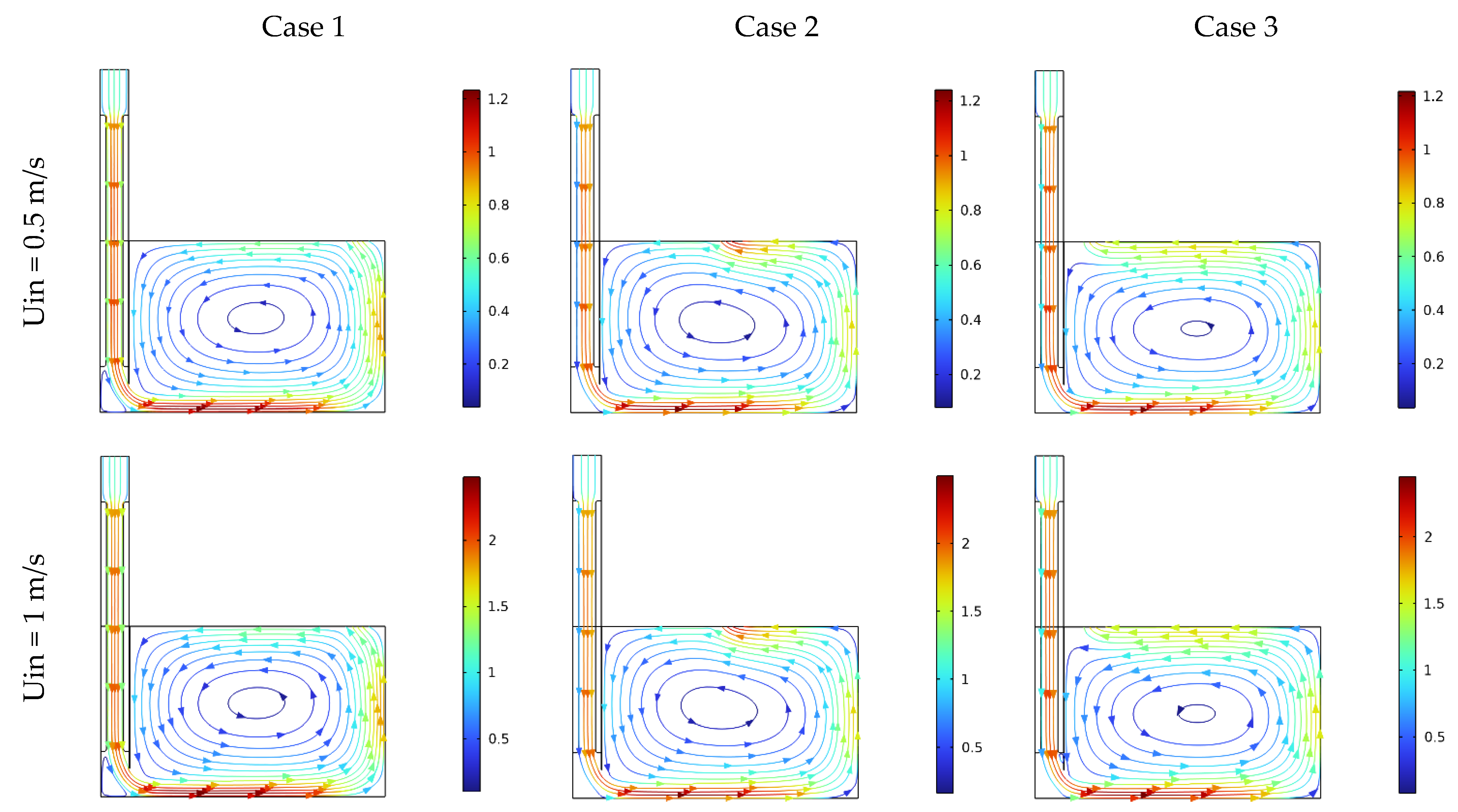
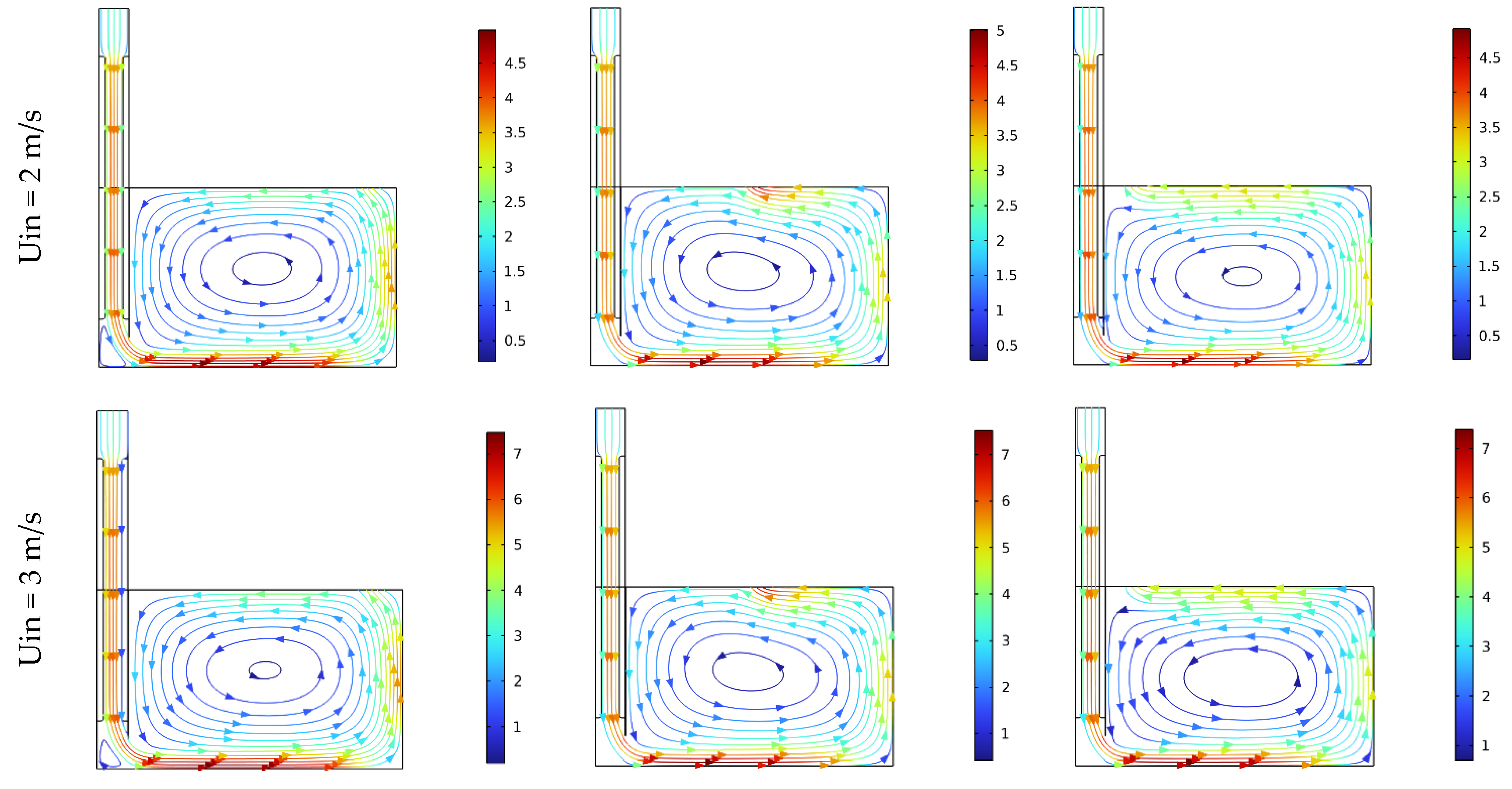

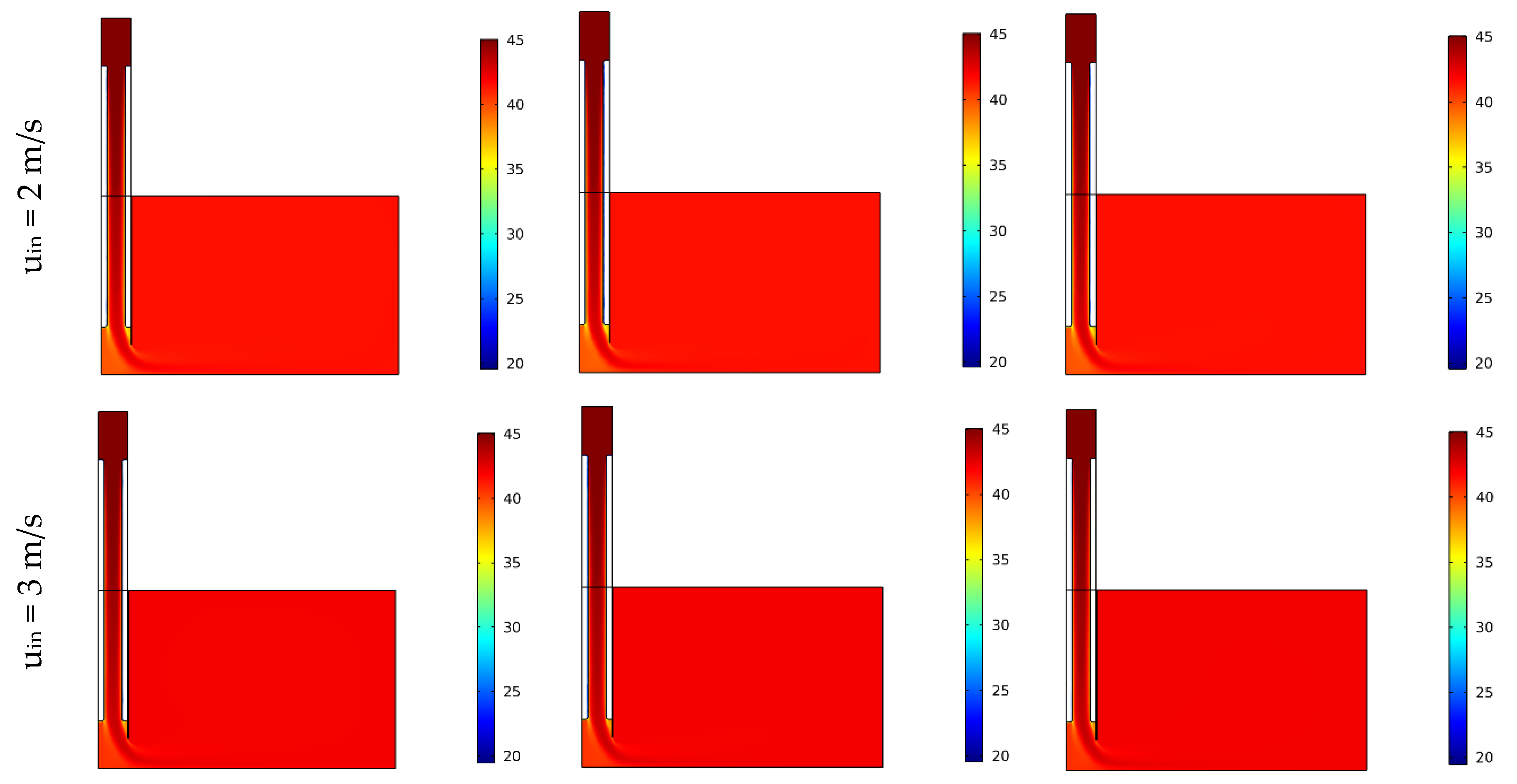



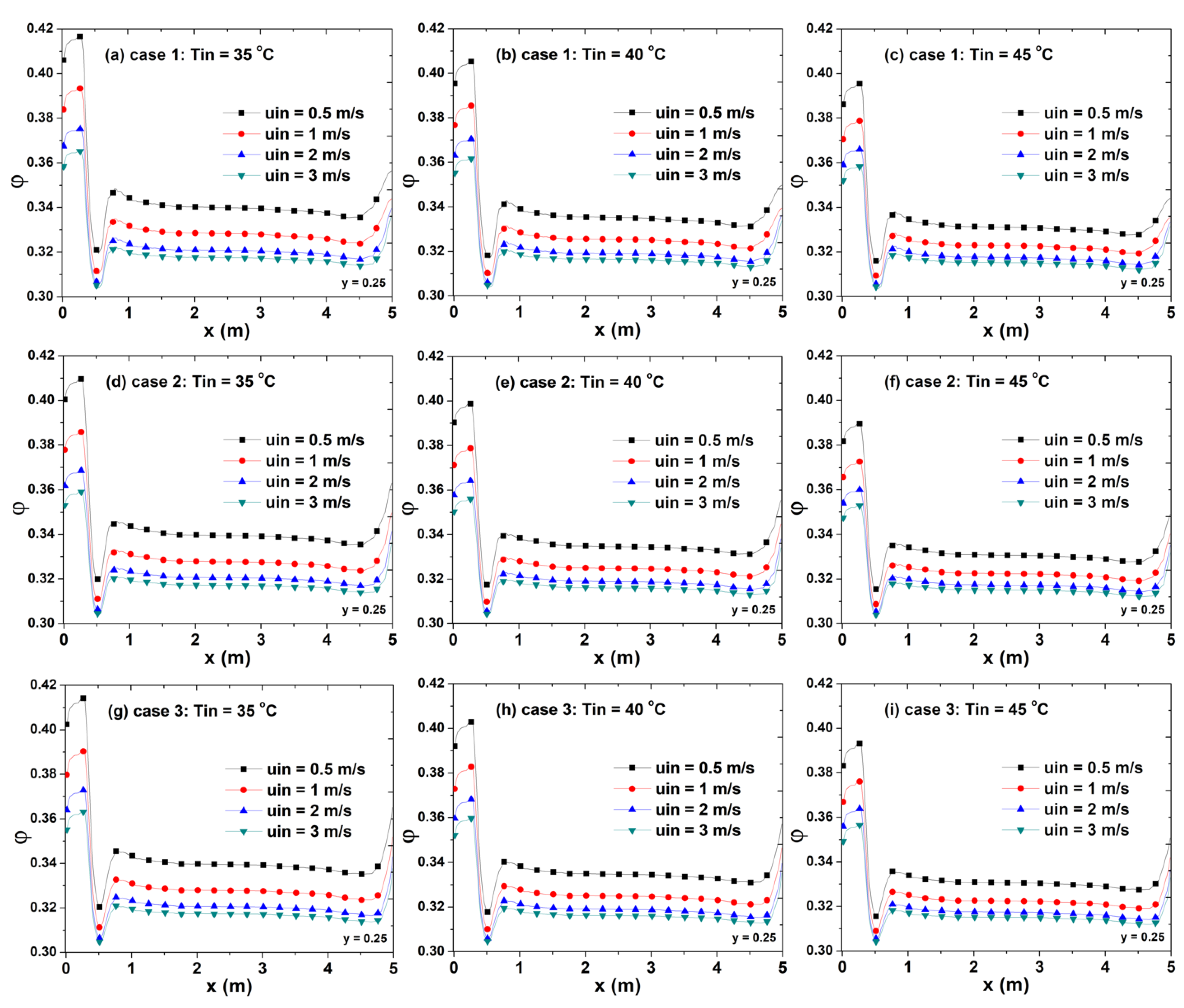
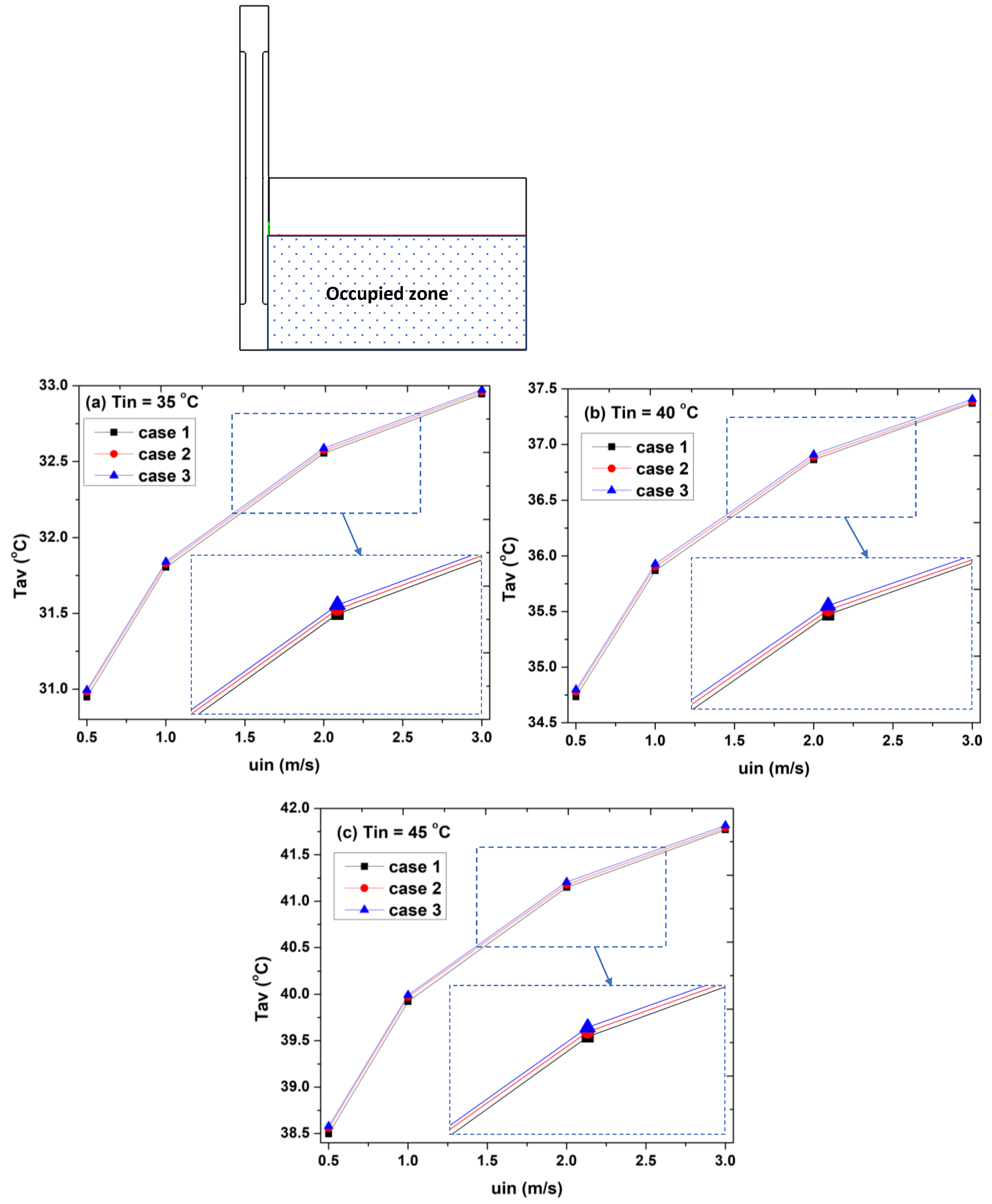
| C1ε | C2ε | C3ε | Cμ | σk | σε |
|---|---|---|---|---|---|
| 1.44 | 1.92 | 0.0 | 0.09 | 1.0 | 1.3 |
| Air | Liquid Water | Water Vapor | |
|---|---|---|---|
| Thermal conductivity (W·m−1·K−1) | 0.025 | 0.59 | 0.026 |
| Specific heat (J·kg−1·K−1) | 1006 | 4180 | 2062 |
| Dynamic viscosity (kg/m−1·s−1) | 1.81 × 10−5 | 1.002 × 10−3 | 1.8 × 10−5 |
| Molar mass (kg·mol−1) | 0.028 | 0.018 | 0.018 |
| Grid | ΔT = Tin − Tav | Increase (%) | Incremental Increase (%) |
|---|---|---|---|
| G1: 13,752 | 2.902 | - | - |
| G2: 16,720 | 2.998 | 3.308063 | - |
| G3: 24,651 | 3.182 | 9.648518 | 6.137425 |
| G4: 59,776 | 3.215 | 10.78567 | 1.037084 |
| Time Step (s) | 2.5 | 5 | 10 | 60 |
|---|---|---|---|---|
| ΔT = Tin − Tav | 3.1764 | 3.182 | 3.224 | 3.2548 |
Publisher’s Note: MDPI stays neutral with regard to jurisdictional claims in published maps and institutional affiliations. |
© 2022 by the authors. Licensee MDPI, Basel, Switzerland. This article is an open access article distributed under the terms and conditions of the Creative Commons Attribution (CC BY) license (https://creativecommons.org/licenses/by/4.0/).
Share and Cite
Alshenaifi, M.A.; Mesloub, A.; Hassen, W.; Abuhussain, M.A.; Kolsi, L. Numerical Analysis of Building Cooling Using New Passive Downdraught Evaporative Tower Configuration in an Arid Climate. Mathematics 2022, 10, 3616. https://doi.org/10.3390/math10193616
Alshenaifi MA, Mesloub A, Hassen W, Abuhussain MA, Kolsi L. Numerical Analysis of Building Cooling Using New Passive Downdraught Evaporative Tower Configuration in an Arid Climate. Mathematics. 2022; 10(19):3616. https://doi.org/10.3390/math10193616
Chicago/Turabian StyleAlshenaifi, Mohammad Abdullah, Abdelhakim Mesloub, Walid Hassen, Mohammed Awad Abuhussain, and Lioua Kolsi. 2022. "Numerical Analysis of Building Cooling Using New Passive Downdraught Evaporative Tower Configuration in an Arid Climate" Mathematics 10, no. 19: 3616. https://doi.org/10.3390/math10193616
APA StyleAlshenaifi, M. A., Mesloub, A., Hassen, W., Abuhussain, M. A., & Kolsi, L. (2022). Numerical Analysis of Building Cooling Using New Passive Downdraught Evaporative Tower Configuration in an Arid Climate. Mathematics, 10(19), 3616. https://doi.org/10.3390/math10193616










